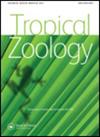Unravelling taxonomic ambiguity of the Mastacembelidae in the Mekong Delta (Vietnam) through DNA barcoding and morphological approaches
IF 0.4
4区 生物学
Q4 ZOOLOGY
引用次数: 4
Abstract
Morphological-based species identification can be problematic for a comparative worldwide survey if taxonomic keys are limited and inconsistent, as illustrated in the family Mastacembelidae. This study combined DNA barcoding and morphological methods to test species identification of Mastacembelidae in the Mekong Delta with emphasis on taxonomic ambiguity of the precise identification of the fish locally known as chach bong. Fish specimens were collected from fishermen in different regions of the delta. Five presumed species within two genera were recorded. Samples were morphologically measured for morphometric and meristic traits. Representative samples of each species were sequenced at the cytochrome c oxidase subunit I (COI) gene. The number of dorsal fin spines and general morphological appearance are distinguishable among the five presumed species. However, morphometric measurements overlapped between Macrognathus semiocellatus and Macrognathus siamensis. K2P distances based on COI sequences among species were high, ranging from 12.4% to 18.7%. All individuals were separated into monophyletic groups of species, clustered into Mastacembelus and two Macrognathus lineages. Chach bong should be recognized as Mastacembelus favus and not Mastacembelus armatus as previously classified. No Mastacembelus armatus was recorded in the Mekong Delta. GenBank sequences of Mastacembelus armatus formed a sister relationship to Mastacembelus favus although both have the same range of number of dorsal fin spines and similar reticulated patterns on the body. Misidentification between these two species has been widely recorded in international databases of species taxonomy and DNA barcodes. Nonetheless, their genetic distance (12.4%) is higher than conspecific distances of samples from other regions, indicating the two species can be differentiated by DNA barcoding.通过DNA条形码和形态学方法揭示越南湄公河三角洲Mastacembelidae的分类歧义
如Mastacembelidae科所示,如果分类键有限且不一致,基于形态学的物种鉴定可能会对全球比较调查产生问题。本研究结合DNA条形码和形态学方法对湄公河三角洲Mastacembelidae的物种鉴定进行了测试,重点是对当地称为chach bong的鱼进行精确鉴定的分类歧义。鱼类标本采集于三角洲不同地区的渔民。记录了2属内的5个推定种。对样品进行形态测定和分生性状测定。对每个物种的代表性样品进行细胞色素c氧化酶亚基I (COI)基因测序。背鳍刺的数量和一般形态外观在五个假定的物种中是可区分的。然而,在半细胞巨嘴鳄和暹罗巨嘴鳄之间的形态测量测量有重叠。物种间基于COI序列的K2P距离较高,为12.4% ~ 18.7%。所有个体被划分为单系群,聚类为Mastacembelus和两个Macrognathus谱系。chachbong应该被认为是Mastacembelus favus,而不是以前分类的Mastacembelus armatus。湄公河三角洲地区未发现犰狳。尽管Mastacembelus和Mastacembelus具有相同的背鳍数量范围和相似的网状图案,但它们的GenBank序列与Mastacembelus favus形成了姐妹关系。在国际物种分类和DNA条形码数据库中,这两个物种之间的误认已被广泛记录。尽管如此,它们的遗传距离(12.4%)高于其他地区样本的同源距离,表明两种物种可以通过DNA条形码进行区分。
本文章由计算机程序翻译,如有差异,请以英文原文为准。
求助全文
约1分钟内获得全文
求助全文
来源期刊

Tropical Zoology
生物-动物学
CiteScore
2.50
自引率
0.00%
发文量
1
审稿时长
>12 weeks
期刊介绍:
Tropical Zoology is an international zoological journal publishing original papers in the field of systematics, biogeography, phylogeny, ecology and conservation of all terrestrial and aquatic animal Phyla from tropical and subtropical areas.
Only papers with new information, high quality and broad interest are considered. Single species description and checklists are not normally accepted. Review papers are welcome. The journal is owned by the Istituto di Ricerca sugli Ecosistemi Terrestri of the Consiglio Nazionale delle Ricerche, Florence, Italy (CNR-IRET) who performs research into the structure and functioning of aquatic and terrestrial ecosystems, focusing in particular on anthropogenic pressure and global change. The knowledge amassed forms the scientific basis for identifying the most appropriate protective and corrective interventions, and provides support for the bodies entrusted with formulating policies for environmental protection and recovery.
 求助内容:
求助内容: 应助结果提醒方式:
应助结果提醒方式:


